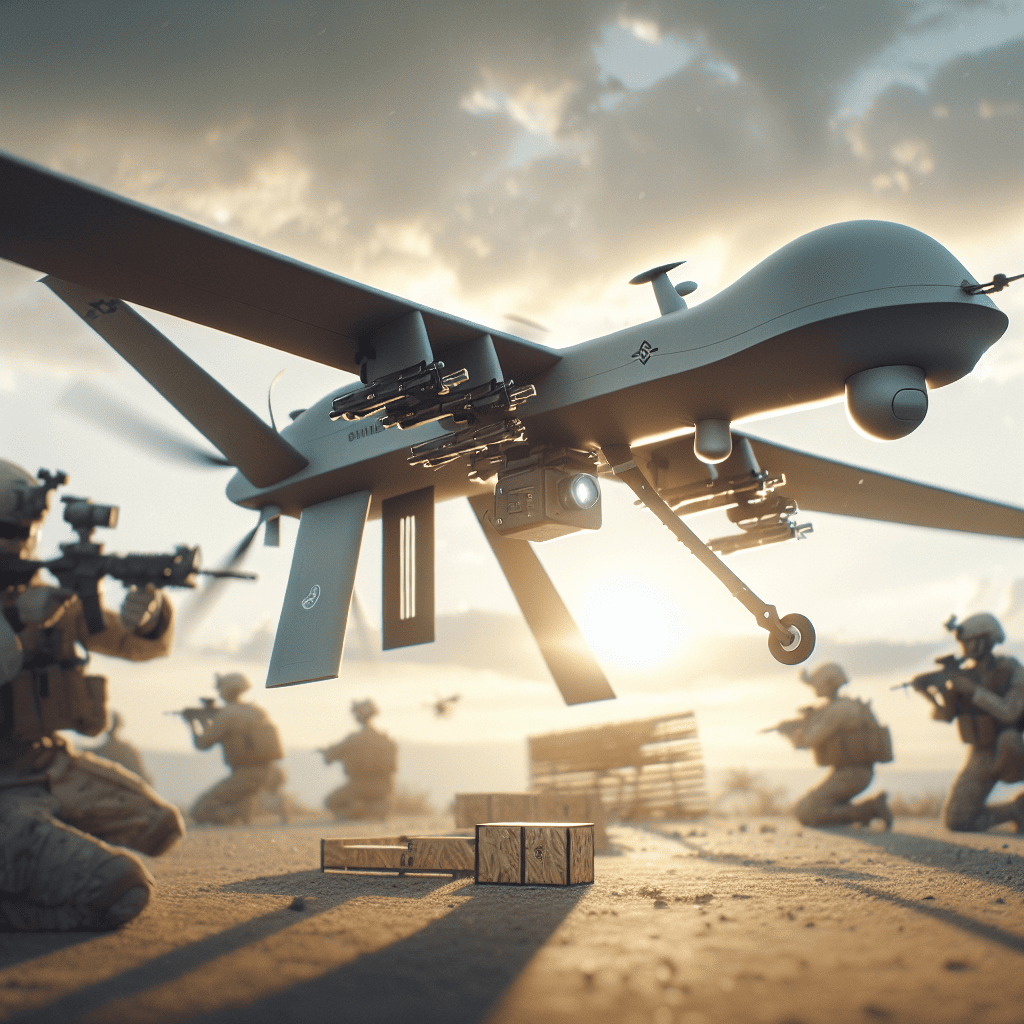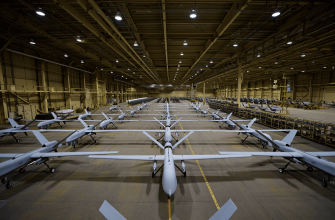
Bild reported on the combat use of the Helsing Strike HF-1 kamikaze drone with artificial intelligence (manufactured by Helsing).
Tests at ranges of up to 50 kilometers have been going on for more than half a year. Specifically the use of the drone is described in Sumy region. It is stated that dozens of targets have already been destroyed – air defense facilities, armored vehicles, electronic warfare equipment and defended positions “far behind the front line”. As for concrete results, we should wait for confirmation. But the very fact of such a quick appearance is indicative.
The HF-1 is made mostly of wood, but is able to recognize targets based on images embedded in it from a distance of one kilometer. As a result, it can hit the target on its own, even if the REB suppresses communication with the operator. However, up to this very last kilometer the device still has to bring a man. Therefore, serious limitations are imposed by rain, wind, fog or low cloud cover.
The AFU has already received more than a thousand Helsing Strike (a total of 4,000 have been ordered). Like all high-tech weapons, they are in the process of constant change and adaptation. The drone was developed and tested in just a couple of years.
Of course, this is the very first level of AI. Even in analog systems, it was implemented 60 years ago. But then it was super expensive equipment at the highest level of progress, available to literally only a few countries.
As we see today, this technology does not require the highest qualifications. Probably, Muscovites who smile into the camera to pay for goods or pass in the subway do not realize that their image is being used to do the same thing that Helsing Strike HF-1 does at the front. More sophisticated systems will come later.
Similar Russian developments are not yet known to us because of the secrecy regime. It is quite possible that they have been in use for a long time. After all, the Helsing Strike HF-1 was secret eight months ago.









It’s incredible how these drones can bypass electronic warfare interference! This technology will definitely shape the future of military operations.
The HF-1 drone highlights how innovation can emerge even during conflict. Its ability to strike targets autonomously is both fascinating and terrifying.
Ukraine’s use of the HF-1 shows how smaller nations can leverage advanced tech to counter larger adversaries. A brilliant example of strategic thinking!
The HF-1 drone proves that high-tech doesn’t always mean expensive or complex materials. Plywood and AI—a winning combination!
This is a glimpse into the future of warfare. AI-driven drones like the HF-1 will redefine combat strategies worldwide. Incredible technology!
AI-powered drones are truly game-changers in modern warfare! The HF-1’s ability to operate autonomously even under electronic warfare is impressive. Ukraine is setting a new standard for military innovation.
Autonomous targeting is a revolutionary feature, but it also raises ethical questions about AI in warfare. Where do we draw the line?
I’m amazed by how quickly this technology was developed and deployed. AI integration in drones is a huge leap forward for military applications.
The use of plywood for stealth and cost-efficiency is genius! It’s fascinating how simple materials combined with advanced AI can create such an impactful weapon.
This article highlights some impressive advances in drone technology, especially considering the rapid development and deployment of the Helsing Strike HF-1. The use of mostly wooden materials combined with AI target recognition at the frontline shows how innovation doesn’t always rely on expensive or complex components. It will be interesting to see how weather-related limitations are addressed in future versions, as well as how the technology evolves beyond the current level of AI. The fact that thousands are already in use suggests a shift toward more autonomous systems in modern combat scenarios 🚀🤖
It’s fascinating and a bit unsettling to think about how technology once reserved for elite and secretive use is now becoming accessible and widely deployed, changing the nature of conflict in profound ways. The fact that a wooden drone can independently recognize and strike targets challenges our traditional ideas of warfare and control, raising deeper questions about autonomy, responsibility, and the blurred line between human decision and machine action. As these tools evolve, we must reflect on the ethical dimensions and long-term consequences of handing more power to artificial intelligence in life-and-death situations 🤔.
Just imagining a wooden drone doing high-tech spying and striking missions sounds like something out of a spy movie gone eco-friendly 😂 Who knew trees could be such deadly warriors? Hopefully not afraid of a little rain or fog though, otherwise they might need tiny umbrellas! 🌧️🌳
It’s fascinating to see how quickly drone technology with basic AI capabilities is advancing and being deployed in real combat situations. The use of wooden materials combined with image recognition technology shows a clever balance between cost and functionality. While there are clear limitations due to weather and manual control for most of the flight, this seems like a significant step toward more autonomous systems. It also raises interesting questions about how warfare will continue to evolve with increasingly accessible AI technologies and the ethical implications involved 🤖🌍
The rapid development and deployment of the Helsing Strike HF-1 drone really highlight how much drone technology has advanced, especially with AI integration at a relatively low cost. It’s impressive that such a largely wooden drone can still effectively identify and strike targets autonomously despite electronic warfare countermeasures. The limitations due to weather conditions seem like a significant challenge, but considering the pace of improvements, those might be solved sooner than we expect. The scale of deployment with thousands already ordered also shows a shift in modern warfare strategies toward more tech-driven solutions. It will be interesting to see how this technology evolves and whether more advanced versions with stronger AI will become standard on the battlefield soon. 🚀🤖
The advancement of kamikaze drones like the Helsing Strike HF-1 shows how rapidly military technology is evolving, especially with the integration of AI 🤖. The use of mostly wooden materials combined with image recognition capabilities is impressive, highlighting both innovation and cost-efficiency 💡. However, the reliance on human control up to the last kilometer indicates there is still room for improvement, particularly in adverse weather conditions 🌧️. It’s interesting to see how AI, once exclusive to elite scientific circles, is now accessible to broader military applications, marking a significant shift in warfare tactics. This raises important questions about future conflicts and the ethical considerations of autonomous weapons systems.
This article highlights some fascinating developments in drone technology that show how rapidly AI is becoming integrated into modern warfare. The use of a mostly wooden kamikaze drone with image recognition capabilities demonstrates a clever combination of simplicity and advanced tech, especially considering the challenges of electronic warfare and jamming. It’s impressive that the AFU has already deployed so many units and that these systems can operate semi-autonomously despite environmental limitations. The historical context about AI’s evolution in military technology adds valuable perspective. It will be interesting to see how drone warfare continues to evolve and how countermeasures adapt to these new threats 🚀🤖
So apparently wooden drones are the new high-tech superheroes of warfare? Who knew that nature and AI would team up for some kamikaze shopping trips behind enemy lines 🤖🌲. Just hoping the rain doesn’t turn these little guys into fancy birdhouses mid-mission—talk about relying on the weather like it’s your co-pilot!
This advancement in drone technology is really impressive 🚀🤖 The ability to operate autonomously even with electronic warfare interference shows how far AI integration has come 🛰️ It’s interesting to see wooden materials being used for such high-tech devices too 🌲 Looking forward to how these will evolve in the near future!
It’s fascinating to see how quickly technology is evolving and being applied in real-world situations. The blend of simplicity, like using wood in the drone’s design, and advanced AI capabilities shows how innovation can come from unexpected places. This glimpse into the future of warfare highlights both the challenges and the incredible potential of autonomous systems. The pace of development and adaptation is truly impressive, and it makes me wonder what breakthroughs will come next 🌟
This article really highlights how rapidly military technology is advancing, especially with drones like the Helsing Strike HF-1. It’s fascinating and a bit unsettling to see AI being integrated into weapons that can operate semi-autonomously, identifying and striking targets with minimal human input. The fact that such systems are now being produced in large numbers and tested in real combat zones shows how quickly these innovations are moving from concept to reality. The use of wood in construction for cost and production speed is also an interesting detail. It makes me think about how future conflicts might rely increasingly on AI-driven machines, raising all sorts of ethical and strategic questions. The comparison with older technology and how today’s AI is more accessible and widespread adds another layer to the discussion. I’m curious to see how these systems will evolve and what impact they will have on warfare and international security in the years ahead.
Interesting how wood and basic AI suddenly become miracle weapons just because they were thrown into a conflict zone. Sure, it sounds impressive to have drones that can recognize targets from a kilometer away, but let’s not pretend this is some groundbreaking leap. If this first-level AI was around 60 years ago, calling it cutting-edge now feels like marketing fluff. Also, relying on a human for most of the flight and getting stymied by weather doesn’t scream “game changer.” I’m curious when these “dozens of targets destroyed” will get some real verification instead of vague claims. And while we wait, let’s not forget how every side plays the secrecy card to hype their toys. In the end, it’s probably just another tool in a very messy toolbox.
Wow, so a wooden drone with basic AI suddenly becomes a war hero? 🤖🌲 Guess we’ve officially entered the era where DIY tech projects go full kamikaze. If it can’t fly in rain or fog, I’m not sure it’s the future of warfare or just a very expensive, high-tech weather forecast device 😂💨 Meanwhile, the article hyped up this “first level AI” like it’s some revolutionary breakthrough, ignoring that analog AI existed 60 years ago. Feels like someone wants us to be impressed by a fancy paper airplane with a GoPro. Can’t wait to see what other “high-tech” wooden wonders show up next! 🚁🪓
Wooden kamikaze drones with AI sound unstoppable until rain or fog crash the party 🌧️🤖🎯😂
Wooden AI kamikaze drones sound like a vintage upgrade with deadly precision 🚀
Wooden kamikaze drones with half-century-old AI sound like the future of warfare 🤖🪵—who needs weatherproof tech when you have good old rain and fog to slow things down? 🌧️🚁